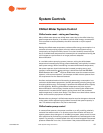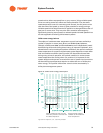
92 Chiller System Design and Control SYS-APM001-EN
System Controls
Variable condenser water flow
Chiller-tower-pump balance
There are times when a system designer may choose to vary the condenser
water flow in addition to, or instead of, the cooling-tower fan speed. This may
be beneficial in systems with high pumping power. If a variable-speed drive
is installed, the flow may be reduced and the pump power can be reduced
substantially—approximately with the cube of the speed. Attempting to vary
both the pump and the tower fan speeds is complex and requires adequate
time for design and implementation.
Keep the flow through the condenser above the minimum allowable flow rate
for the chiller’s condenser. The operator should regularly log the condenser
approach temperature (the temperature difference between the condenser’s
refrigerant temperature and the condenser-water leaving temperature) to
ensure that the tubes are not becoming fouled. The approach temperature
may be monitored using a chiller plant management system.
Tower and/or tower nozzle design can affect the allowable condenser-water
flow. If the flow drops below the manufacturer’s specified limit, the water is
no longer evenly distributed over the tower fill. This results in a decrease in
cooling-tower heat-transfer effectiveness. In extreme cases, it can also result
in water freezing in the cooling tower. If variable tower flow is a
consideration, contact the cooling-tower manufacturer to determine the flow
limit and possibly choose nozzles or cooling-tower configurations that can
handle variable-water flow.
Most water-cooled, chilled-water systems use a constant condenser water
flow rate. However, the condenser water flow rate can be varied between the
minimum and maximum flows allowed for the specific chiller (refer to
product catalog or selection program).
But reducing the condenser water flow rate affects the power consumption of
the pumps, chiller, and cooling tower, as described below:
• Condenser water pump: Pump power is reduced because both the flow
rate and the pressure drop through the piping and condenser are
reduced.
• Chiller: Compressor power is increased because, as the flow rate
decreases, the temperature of the water leaving the condenser increases.
At a given load, this increases the compressor lift and, therefore, its
energy use.
• Cooling tower: As explained above, the temperature of the water
returning to the cooling tower is warmer. This increases the effectiveness
of the heat exchanger. But the water flow rate is decreased, which can
either improve or reduce the effectiveness of the cooling tower. So, for a
given load, reducing the flow rate through the cooling tower sometimes
decreases and sometimes increases energy use.


















